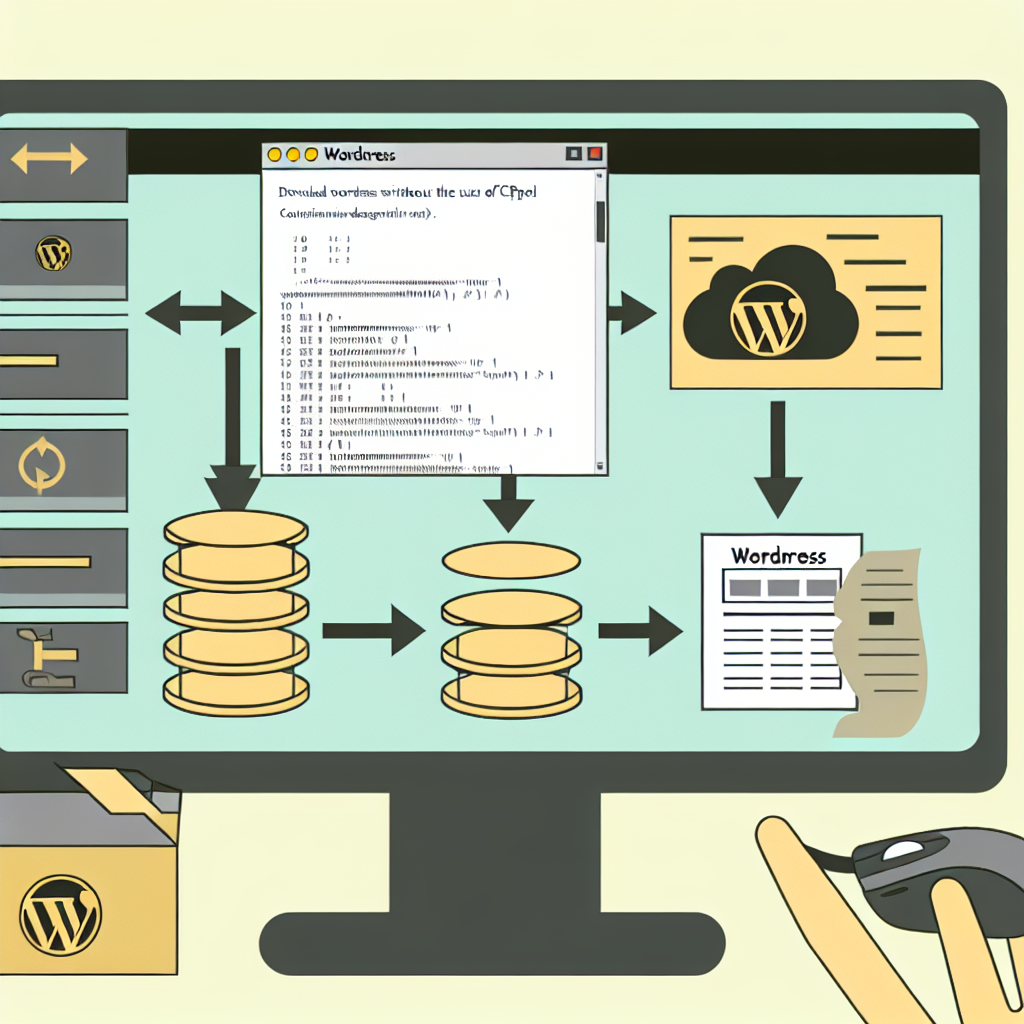### How to Launch WordPress Without cPanel
In the ever-evolving world of web development, many aspiring website owners find themselves seeking ways to streamline their processes. One such method is to **start a WordPress website without cPanel**—a popular hosting management tool that can sometimes complicate the setup for beginners. Whether you’re a seasoned developer or a newcomer to the digital landscape, the ability to create a WordPress site without relying on cPanel opens up new avenues for flexibility and control.
In this article, we will explore the essential steps to effectively launch your WordPress website without cPanel, providing you with a professional and informative guide that empowers you to take charge of your online presence. From understanding the necessary tools and resources to troubleshooting common challenges, we’ve got you covered. Let’s dive into the world of WordPress and discover how you can easily set up your website without the constraints of traditional hosting management systems.
- Here are three possible section headlines for your article on starting a WordPress website without cPanel:
- 1. **Understanding the Basics: What You Need to Start WordPress Without cPanel**
- 2. **Step-by-Step Guide: How to Set Up Your WordPress Website Without cPanel**
Here are three possible section headlines for your article on starting a WordPress website without cPanel:
### How to Launch WordPress Without cPanel
Starting a WordPress website without cPanel may seem daunting at first, especially for those who are accustomed to traditional hosting environments. However, many alternatives can simplify the process and empower you to get your site up and running in no time. In this guide, we will walk you through the steps to launch your WordPress website seamlessly, even without cPanel.
#### Understanding the Basics of Hosting
Before diving into the specifics of starting a WordPress website without cPanel, it’s essential to understand the hosting environment. Here are some key points to consider:
– **What is cPanel?**: cPanel is a popular web hosting control panel that provides a graphical interface and automation tools designed to simplify the process of hosting a website. However, not all hosting providers use cPanel.
– **Alternatives to cPanel**: Many hosting services offer custom dashboards or alternative management tools that can be just as effective as cPanel.
– **Choosing the Right Hosting Provider**: Opt for a hosting provider that allows you to install WordPress without relying on cPanel. Services like VPS hosting, managed WordPress hosting, or even cloud hosting can be excellent options.
#### Step-by-Step Guide to Start Your WordPress Website Without cPanel
Follow these steps to successfully launch your WordPress website without using cPanel:
1. **Select a Hosting Provider**: Choose a hosting provider that offers WordPress installation options without cPanel. Look for features such as one-click installations or FTP access.
2. **Set Up Your Domain**: If you haven’t already, register a domain name. Most hosting providers offer domain registration services, which can simplify the process.
3. **Connect to Your Hosting Account**:
– Use FTP (File Transfer Protocol) to connect to your hosting account. You will need an FTP client (like FileZilla) to upload files.
– Enter your FTP credentials, which are usually provided by your hosting provider.
4. **Download WordPress**: Go to the official WordPress website and download the latest version of WordPress.
5. **Upload WordPress Files**:
– Extract the downloaded WordPress ZIP file.
– Use your FTP client to upload the extracted files to your hosting account’s root directory.
6. **Create a Database for WordPress**:
– Access your hosting provider’s dashboard (which may not be cPanel) to create a MySQL database.
– Note down the database name, username, and password, as you will need these during the WordPress installation process.
7. **Configure wp-config.php**:
– Rename the `wp-config-sample.php` file to `wp-config.php`.
– Open it and fill in your database details.
8. **Run the Installation**:
– Visit your domain to initiate the WordPress installation process.
– Follow the on-screen instructions to complete the setup.
9. **Customize Your Site**: Once installed, log into your WordPress dashboard and start customizing themes, plugins, and content.
#### Why Start WordPress Without cPanel?
Many users wonder why they should start a WordPress website without cPanel. Here are a few advantages:
– **Flexibility**: Without cPanel, you may have access to more customized options tailored to your specific hosting environment.
– **Learning Opportunity**: Setting up your site without cPanel can deepen your understanding of WordPress and web hosting fundamentals.
– **Cost-Effective**: Some hosting providers offer lower prices for services that do not include cPanel.
### Conclusion
Starting a WordPress website without cPanel is entirely feasible and can open up new avenues of flexibility and learning. By following the steps outlined above, you can set up your site efficiently and effectively.
Ready to take the plunge? Start your WordPress website without cPanel today and discover the freedom of managing your site on your own terms. For more tips and resources, feel free to explore our blog or contact us for personalized assistance!
1. **Understanding the Basics: What You Need to Start WordPress Without cPanel**
### How to Launch WordPress Without cPanel
Starting a WordPress website without cPanel may seem daunting at first, but with the right guidance, it can be a straightforward process. Whether you’re looking for alternatives to traditional hosting methods or simply want to manage your site differently, this article will provide you with all the necessary steps and insights. Let’s dive in and learn how to start a WordPress website without cPanel effectively!
## Understanding the Basics: What You Need to Start WordPress Without cPanel
Before you begin your journey to start a WordPress website without cPanel, it’s essential to understand the fundamental components required for launching your site successfully. Here’s a breakdown:
1. **Domain Name**: Your website’s address on the internet (e.g., www.yourwebsite.com). Choose a domain that reflects your brand or the content of your site.
2. **Web Hosting**: Unlike cPanel, which is often used to manage hosting services, you can opt for other hosting solutions such as:
– **Managed WordPress Hosting**: Providers like Kinsta, WP Engine, or SiteGround offer tailored services for WordPress, eliminating the need for cPanel.
– **VPS Hosting**: Virtual Private Servers give you more control over your hosting environment without a cPanel interface.
– **Cloud Hosting**: Solutions like Amazon Web Services (AWS) or Google Cloud allow for scalable hosting without traditional control panels.
3. **FTP Client**: File Transfer Protocol (FTP) clients like FileZilla will help you upload files directly to your server without needing cPanel.
4. **Database Access**: You will need to create a MySQL database for your WordPress installation. This can often be done through your hosting provider’s dashboard or via command line if you’re comfortable with it.
5. **WordPress Installation Files**: Download the latest version of WordPress from the official site. You’ll need to upload these files to your hosting server.
6. **Basic Technical Knowledge**: Familiarity with FTP, databases, and file management will ease the process of starting your WordPress website without cPanel.
## Step-by-Step Guide to Start WordPress Without cPanel
### Step 1: Register Your Domain and Choose Hosting
– Select a domain name that represents your brand.
– Choose a hosting provider that fits your needs, ensuring they support WordPress installations.
### Step 2: Upload WordPress Files
– Use your FTP client to connect to your server.
– Upload the WordPress files you downloaded earlier to the desired directory on your server.
### Step 3: Create a Database
– Access your hosting account dashboard (without cPanel) and navigate to the database management section.
– Create a new MySQL database and user, and assign the user to the database with full permissions.
### Step 4: Configure wp-config.php
– Locate the `wp-config-sample.php` file in your uploaded WordPress files.
– Rename it to `wp-config.php` and edit it to include your database name, user, and password.
### Step 5: Run the Installation
– Open your web browser and visit your domain name.
– Follow the on-screen prompts to complete the WordPress installation.
### Step 6: Customize Your WordPress Site
– Once installed, log into your WordPress dashboard.
– Choose a theme, install necessary plugins, and start creating content!
## Conclusion
Starting a WordPress website without cPanel is not only possible but can also be a rewarding experience. By understanding the basics and following the outlined steps, you can successfully launch your site tailored to your preferences. Don’t let the absence of cPanel intimidate you; take control of your web presence today!
**Ready to start your WordPress journey?** Begin by registering your domain and exploring hosting options that suit your needs. If you need further assistance or tips, feel free to reach out or explore our other resources!
2. **Step-by-Step Guide: How to Set Up Your WordPress Website Without cPanel**
### How to Launch WordPress Without cPanel
Starting your own WordPress website can seem like a daunting task, especially if you’re unfamiliar with web hosting interfaces like cPanel. However, it is entirely possible to start a WordPress website without cPanel. This guide will walk you through the process of launching your website using alternative methods, ensuring that you have a seamless and efficient setup.
#### Why Choose to Start a WordPress Website Without cPanel?
Opting to start a WordPress website without cPanel offers several advantages:
– **Simplicity**: You can bypass the complexities of cPanel if you’re using platforms like FTP or SSH.
– **Speed**: Direct installation methods can reduce the time taken to get your site up and running.
– **Flexibility**: Gain more control over your website’s environment and configurations.
### Step-by-Step Guide: How to Set Up Your WordPress Website Without cPanel
Setting up your WordPress website without cPanel can be accomplished through several methods. Here’s a detailed step-by-step guide to help you navigate the process:
#### 1. Choose a Hosting Provider
Before you can start your WordPress website, you need to select a reliable hosting provider that supports WordPress installations without cPanel. Some popular options include:
– **DigitalOcean**
– **Vultr**
– **Linode**
These providers offer straightforward server setups and often come with tutorials to assist in website installation.
#### 2. Access Your Server
Once you have chosen your hosting provider and created an account, you will need to access your server. This can typically be done via:
– **SSH (Secure Shell)**: Use an SSH client (like PuTTY or Terminal) to connect to your server using the credentials provided by your hosting service.
– **FTP (File Transfer Protocol)**: You can use an FTP client (like FileZilla) to upload files to your server.
#### 3. Install WordPress Manually
After accessing your server, follow these steps to install WordPress:
– **Download WordPress**: Visit the official WordPress website and download the latest version of WordPress.
– **Upload Files**: Use your FTP client to upload the WordPress files to your server’s root directory (usually `public_html` or `www`).
– **Create a Database**: Use MySQL commands through SSH to create a database for your WordPress installation. For example:
“`bash
mysql -u username -p
CREATE DATABASE wordpress_db;
CREATE USER ‘wp_user’@’localhost’ IDENTIFIED BY ‘password’;
GRANT ALL PRIVILEGES ON wordpress_db.* TO ‘wp_user’@’localhost’;
FLUSH PRIVILEGES;
EXIT;
“`
#### 4. Configure WordPress
Next, you need to configure WordPress by editing the `wp-config.php` file:
– **Locate `wp-config-sample.php`**: Rename it to `wp-config.php`.
– **Add Database Credentials**: Fill in your database details:
“`php
define(‘DB_NAME’, ‘wordpress_db’);
define(‘DB_USER’, ‘wp_user’);
define(‘DB_PASSWORD’, ‘your_password’);
define(‘DB_HOST’, ‘localhost’);
“`
#### 5. Complete Installation
Finally, complete the installation by navigating to your domain in a web browser. You will be guided through the WordPress installation process, where you can set up your website title, username, password, and email address.
### Conclusion
Starting a WordPress website without cPanel may initially appear challenging, but with the right steps, it can be a straightforward process. By choosing a suitable hosting provider and following this guide, you can successfully launch your site and enjoy all the benefits that WordPress has to offer.
Ready to take the plunge? Start your WordPress website without cPanel today and unlock a world of possibilities for your online presence! If you have questions or need further assistance, don’t hesitate to reach out for more guidance.

